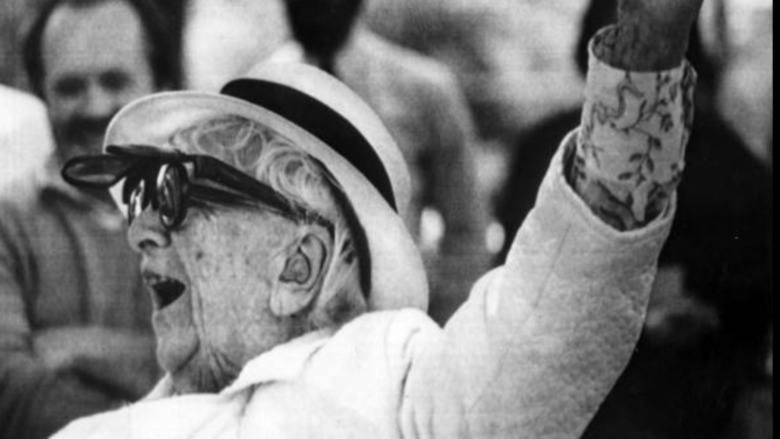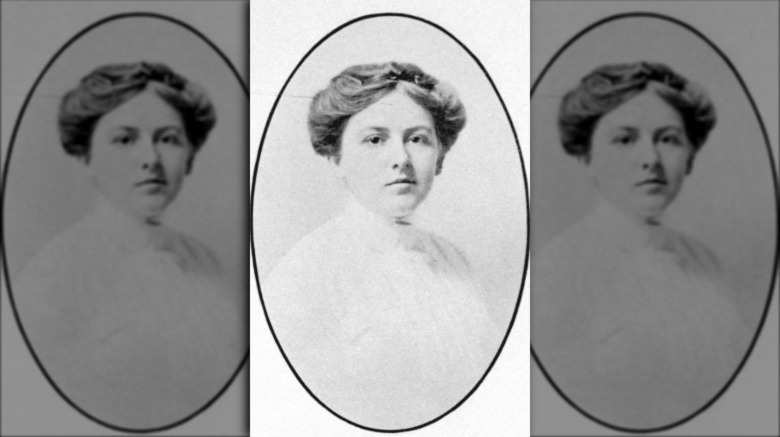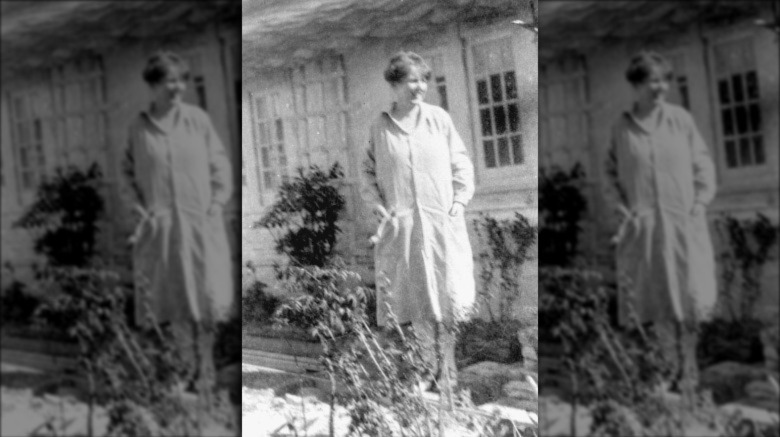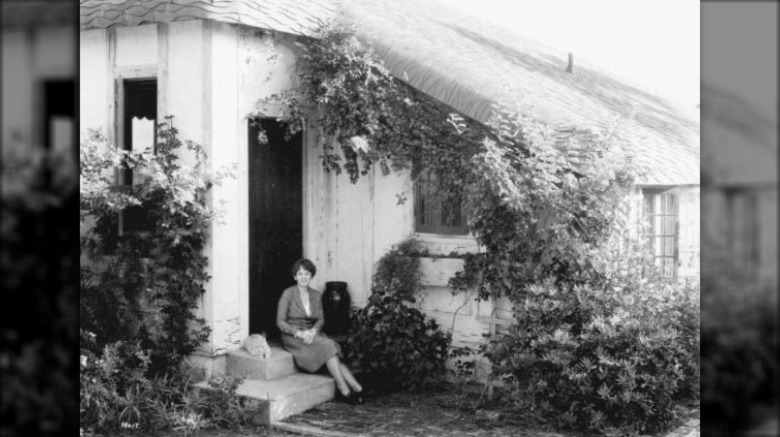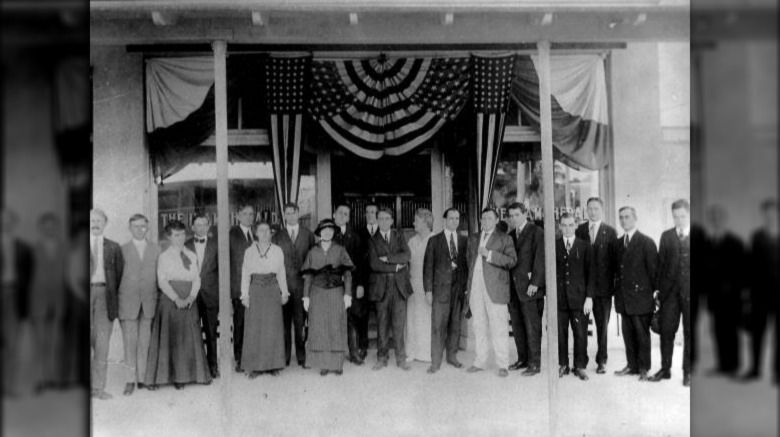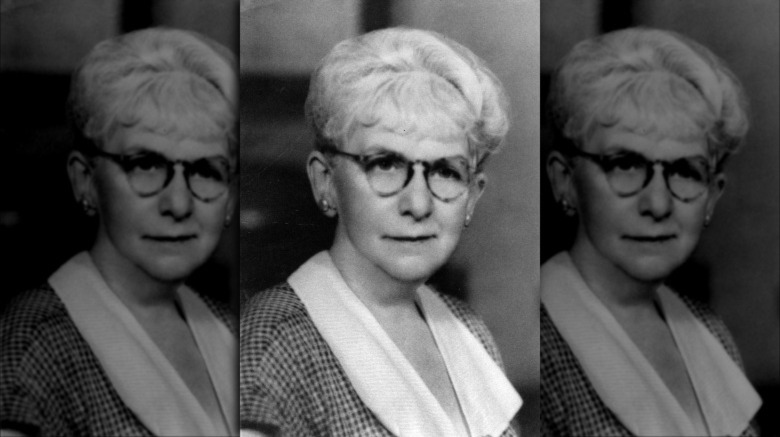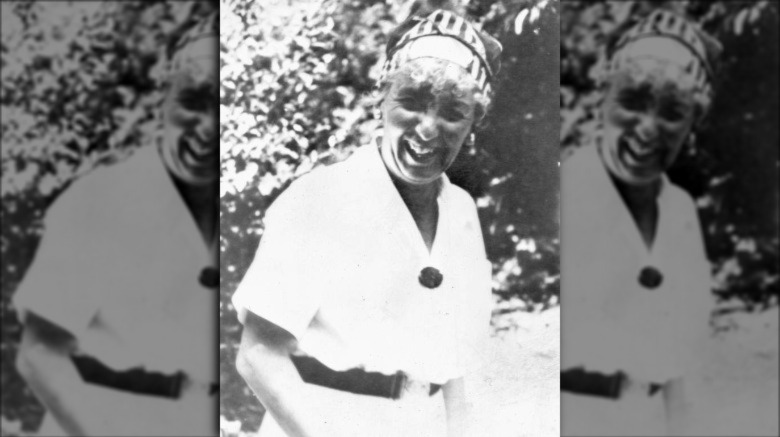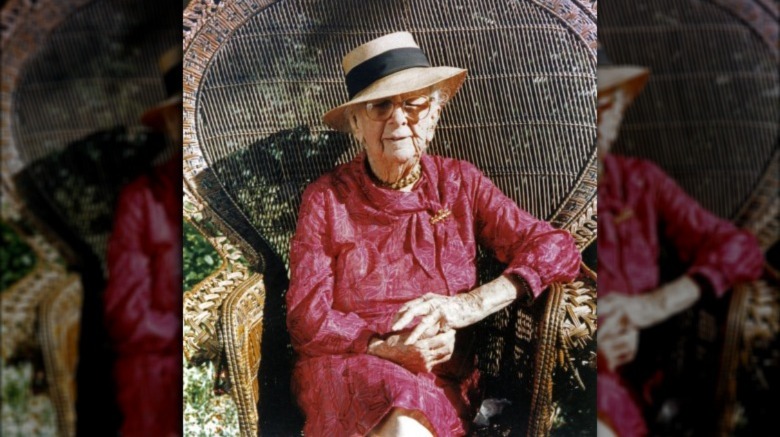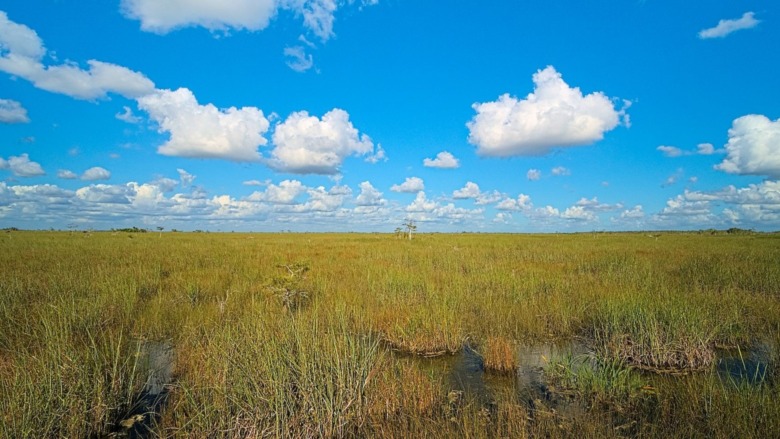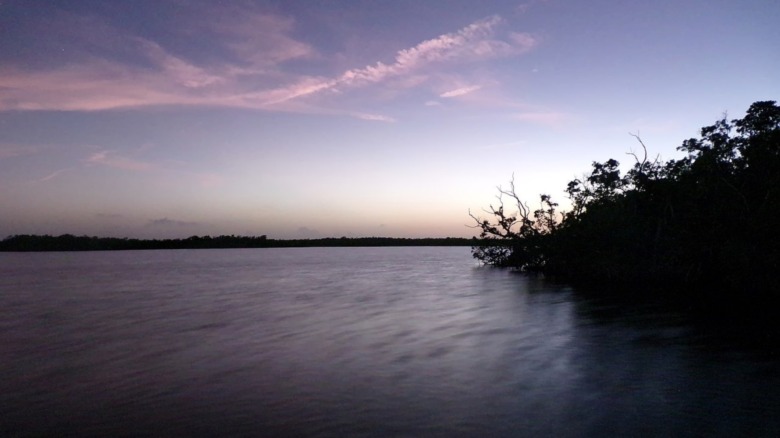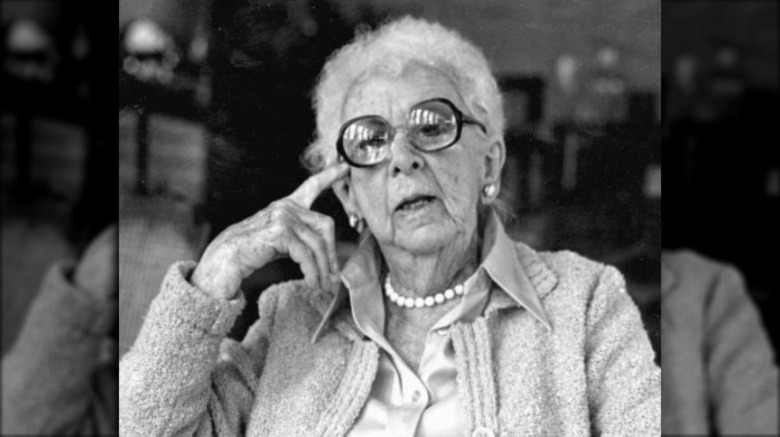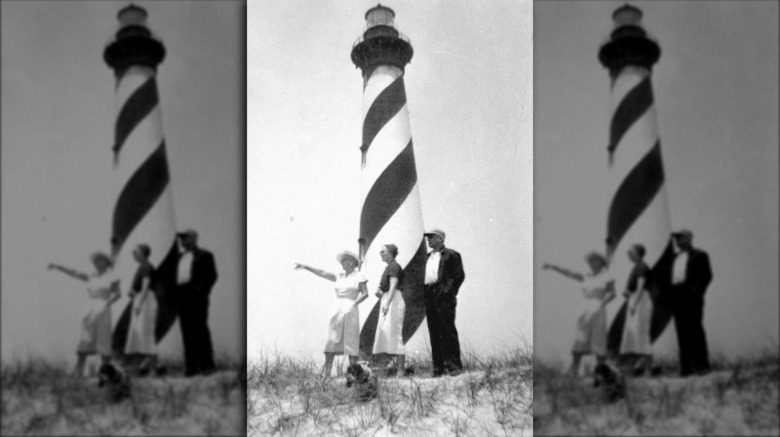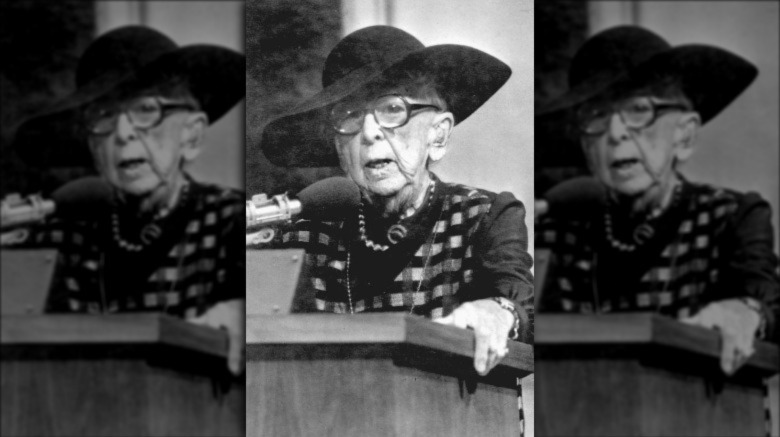The Untold Truth Of Marjory Stoneman Douglas
Florida tends to get a pretty bad rap. When people aren't making jokes about "Florida man" — the result of open public records, by the way, according to the Pensacola News Journal — they're often reducing the state to picturesque beaches and, of course, Disney World. And while there's no denying that oceanfront property is a big draw and the Mouse just about runs all of Orlando, that's not the whole of Florida. In fact, the Sunshine State boasts a unique set of wilderness areas that are full of life but often ignored.
That is, they might have been if it weren't for a woman named Marjory Stoneman Douglas. A writer and prominent environmentalist, Douglas was also a vocal and unforgettable presence in Florida history. She and her associates were critical in protecting the somewhat less-beloved parts of the state, including the 1.5 million acres of South Florida wilderness now known as Everglades National Park. Without Douglas' advocacy and her foundational 1947 work, The Everglades: River of Grass, it's very possible that this unique and vital part of the Florida landscape would have been drained and turned into yet another stretch of concrete.
Douglas herself was a complicated person whose legacy encompasses not only environmental advocacy, but a wide variety of other causes, fiction and nonfiction writing, journalism, traveling, and much more. This "grande dame of the Everglades," as Marjory Stoneman Douglas came to be known towards the end of her long life, was a consequential person indeed.
Marjory Stoneman Douglas had a tumultuous childhood
By all accounts, the young Marjory Stoneman Douglas had a complicated upbringing. First, Marjory's parents split when she was six, according to the National Women's History Museum. Her mother, Florence, took Marjory to live with Florence's parents in Taunton, Massachusetts. Marjory would not have contact with her father until after she graduated from Wellesley College in 1912.
Upon her graduation, Marjory's family immediately gave her terrible news that they'd been concealing: Florence was dying of cancer. Per Marjory Stoneman Douglas: Voice of the River, Marjory already knew that her mother had been dealing with breast cancer, but didn't know that it had metastasized and was occasionally pushing Florence into brief comas. "It was terrible to see her suffer," Marjory later wrote, her memories perhaps compounded by the fact that Florence had been suffering for so long without the knowledge and support of her daughter. When her mother finally died, Marjory was left to arrange the funeral herself.
She later said that the tense environment growing up gave her night terrors and made her "a skeptic and a dissenter," as she wrote in her memoirs. Marjory understood herself to be an oddball within her family and community, whether it was because she didn't play with dolls the "right" way or was more interested in reading than anything else. She wrote that, as a recent college graduate moving out after her mother's death, "I was glad to have escaped the house."
Marjory Stoneman Douglas was a considerable writer
Early on, it was clear Marjory Stoneman Douglas was a voracious reader and a good writer. "In high school, I think I already had a writer's temperament. I became what you'd call a hunter in libraries," she later recalled (via University of Miami). It remained much the same when she started attending Wellesley College in 1908, where she distinguished herself as a dedicated writer, though she once ran afoul of a teacher who told Douglas that a letter she wrote back home for an assignment wasn't the right sort of missive. The teacher had Douglas read it aloud in class as an example of what not to do but was likely a bit surprised to see that Douglas' work instead earned the acclaim of her classmates. Douglas would later be elected the "Class Orator" and worked as an editor for school publications.
In her adult life, Douglas won accolades for her nonfiction and fiction work, including the O. Henry Award for short stories in 1927 and 1928, according to the University of Miami. Though she's now best known for her nonfiction work like 1947's The Everglades: River of Grass, it's clear that the intellectually expansive Douglas wasn't interested in limiting herself to just one genre or style of writing.
Marjory Stoneman Douglas didn't move to Florida until well into adulthood
Bright as Marjory Stoneman Douglas' star seemed to shine in college, things started to go awry after graduation. After her mother's death, Marjory moved to Boston and started in on a series of surprisingly dead-end jobs. According to the South Florida Sun Sentinel, these occupations included work in a department store. While there's certainly no shame in working in retail, as many today can tell you, it seemed an odd choice for someone who had been dead set on becoming a writer. Marjory moved around a bit during this time, including a fateful stint in Newark, New Jersey, where she met a reporter named Kenneth Douglas.
At first, Kenneth Douglas seemed to be a good catch, though Marjory did note that he was about three decades her senior. They married anyway. But not long after their marriage, the terrible truth came out: Kenneth was a conman. He took Marjory across the city as they constantly moved away from creditors and was even jailed for running afoul of a few banks. An uncle eventually persuaded Marjory to cut her losses and leave.
After her marriage collapsed, Marjory moved to Miami to be with her father, Frank Bryant Stoneman, whom she hadn't seen since she was six. She arrived in Miami in 1915, when it was "no more than a glorified railroad terminal," as she recalled in Marjory Stoneman Douglas. Yet, it would prove to be a fruitful move for Marjory's burgeoning writing career.
Marjory Stoneman Douglas got her start at her dad's newspaper
Marjory Stoneman Douglas moved to Miami with a pretty decent job already lined up, as her father was the owner of The Miami Herald, one of the then-relatively small town's newspapers. Douglas later baldly admitted that her hiring there was "pure nepotism," but one can hardly blame her for taking advantage of the opportunity to finally become the writer she always wanted to be (via Orlando Sentinel).
Douglas' first work with The Miami Herald in 1915 was as an editor and reporter focused on the rather fluffy society beat, according to the National Women's History Museum. Her tenure there was briefly interrupted when the United States entered World War I. At that time, Douglas entered the Naval Reserve for a year, which had her stationed in Miami. Perhaps a little stultified at the prospect of staying home during the war, Douglas left the Navy and began work with the American Red Cross in Europe.
While in Europe, The American Prospect reports, Douglas didn't set down her pen or typewriter. She continued writing, filing articles for the Associated Press as she traveled through the region. After the war officially ended, she stayed behind in Paris for a time to help care for refugees from war-torn regions. She eventually returned to Miami and her old job at the Herald in 1917, though she would no longer be content to write about the latest social goings-on thereafter.
Marjory Stoneman Douglas was a vocal women's suffragist
Douglas became involved with women's rights during her college years at Wellesley, where, as she wrote in Marjory Stoneman Douglas, women's suffrage was a major issue. She was among the original members of the college's Suffrage Club, a cause supported not only by Douglas and her classmates, but her grandmother and teachers.
While working at the Herald, her father assigned Douglas to write a column on "women's issues," largely politically inconsequential social events like tea parties and weddings. Douglas, however, pushed back and began writing about women's suffrage, along with other social and environmental topics of the time. And she didn't confine her advocacy to the newspaper, either. As The American Prospect reports, after her return from World War I, Douglas and a group of three other women traveled to the state capital of Tallahassee to lobby for women's suffrage there.
"It was like speaking to blank walls," she recalled of the group's encounter with lawmakers, speaking in a 1983 interview via the Everglades Digital Library. "They didn't pay any attention to us at all [...] I thought then that it was a backwards state and I still have some of that idea."
Douglas dealt with mental health challenges
Mental illness was a recurring issue in Marjory Stoneman Douglas' immediate family. While she was still young, her mother Florence had the first of numerous "mental breakdowns," as Marjory termed them in her memoir. Some suspected that the issue was related to a long line of mental health struggles in the family, though it appears that Marjory herself never got much concrete information about the matter. Still, it was clear to everyone that Florence needed help.
For a while, a nurse managed Florence's care, but then she was briefly institutionalized. "I don't know how long it was," Marjory wrote, "but when she came back she was outwardly a different woman." Marjory herself experienced traumatic aftereffects stemming from this family drama, including nightmares that "carried on for a good many years."
Marjory herself would experience three nervous breakdowns and multiple "blank spaces," wherein she couldn't remember what had happened over the course of a few minutes. "Maybe I inherited some flaw that my mother had," she wondered, recalling that she had experienced her first breakdown in 1924, which led to her leaving the Miami Herald. Later, according to An Everglades Providence, Marjory experienced another breakdown. Neighbors found her shouting and wandering down the street in her nightgown. However, these episodes seemed to have been rare and short-lived, allowing Marjory to continue her work as a writer and activist.
She was an activist for quite a few other causes, too
While Marjory Stoneman Douglas clearly devoted a fair amount of her time to women's suffrage and, later, environmentalism, she was no slouch when it came to other social issues. Douglas was also a supporter of the Equal Rights Amendment, The American Prospect reports, campaigning for the legislation during the 1970s. Douglas was also an original member of the first chapter of the American Civil Liberties Union to be founded in the South. She was especially interested in improving conditions for different people in Florida, lending her support to causes as varied as public libraries, farm worker protections, and improving access to the natural world.
During the 1940s, Douglas realized that many people living in Coconut Grove, then a segregated and majority-Black neighborhood of Miami, were forced to live without running water and toilets in their homes. Douglas herself lived in the neighborhood for over 70 years, from 1925 until 1998 (via Florida State Parks). As part of her work to help improve access to what we now consider a basic utility, Douglas worked to set up interest-free loans for neighborhood residents.
According to Florida State Parks, President Bill Clinton later gave Marjory Stoneman Douglas the Presidential Medal of Freedom in 1993. By then, she was best known for her environmental advocacy, but her progressive legacy of work shows that she was the real activist deal.
Douglas didn't write about the Everglades until the 1940s
Though Marjory Stoneman Douglas would eventually become best known for her advocacy on behalf of Florida's natural environment, she didn't seriously start getting into the cause of the Everglades until well after her move to Florida. Douglas may have also been influenced somewhat by her father. According to Wilderness Connect, Frank Stoneman had already written newspaper pieces that criticized Florida Governor Napoleon Bonaparte Broward, who was an early proponent of simply draining the Everglades and taking the land that was left behind.
Douglas had already become a seasoned reporter when she was asked to write a series of books about America's rivers, per Biography. She didn't really want to write about the nearby and small Miami River, so she pivoted to the Everglades, which she called "the river of grass." That phrase would become the subtitle of her famous nonfiction book on the region published in 1947, titled The Everglades: River of Grass.
Douglas also recalled an encounter with poachers during an earlier tour of the area that illustrated local opposition to environmentalism in a 1983 interview. Douglas was part of an early team surveying the area via houseboat when the group encountered egret poachers who openly admitted that they were going to hunt the birds for their plumage. She decried the destruction, where the poachers killed all the adults and left the hatchlings to die. "Why our people didn't protest against that, I don't know," she said.
The road to the Everglades National Park was bumpy
Marjory Stoneman Douglas was an early defender of the Everglades but getting everyone else to agree with her and her associates, along with securing federal funding, was tough. According to a 1983 interview with Douglas hosted at the Everglades Digital Library, it all began with a man named Ernest Coe. He teamed up with Douglas' father to create a committee to establish the park and Douglas eventually joined the committee. The group occasionally took scientists, government officials, and other parties to the Everglades, including at least one trip in a dirigible, all in an effort to convince them of the area's need for protection.
One of those people was Arno Cammerer, who would eventually become head of the National Park system. The group, seemingly pretty impressed with the natural environment of the Everglades and, at least in Douglas' recollection, the massive numbers of birds that lived there, "unanimously decided that it must be a great National Park."
The national park was first authorized in 1934 but wasn't actually established until 1947 because of issues getting the land needed for the park, Britannica says. Even then, getting people to support the effort was difficult. Per Biography, Douglas admitted that environmentalism was little more than an odd word back then. "There was no organized environmental movement until the late 1960s, and little understanding of what ecology is about," she said.
Marjory Stoneman Douglas understood that the Everglades could be tough to love
As much as Douglas would prove to be a formidable advocate for the Everglades and the natural environment of Florida, she wrote in Marjory Stoneman Douglas that "to be a friend of the Everglades is not necessarily to spend time wandering around out there."
The large wilderness of South Florida is generally hot, humid, and too full of insects, alligators, birds, and other creatures to make classic outdoor activities like camping enjoyable for many. Yet, Douglas, though she wasn't a fan of actually going out there and communing with bug-ridden nature, understood that the wetlands are a vital part of the ecosystem, providing critical water resources and animal habitats. "I know it's out there and I know its importance," she wrote in her memoirs.
People have had a complicated relationship with Florida's subtropical wilderness for a long time. In The Orchid Thief, writer Susan Orlean maintained that "the wild part of Florida is really wild" and always seems to exist right next to humanity's attempts to manage that unruly, uncomfortable wilderness. But where people like Governor Broward wanted to drain the swamps and put in a profitable housing development or business park, Douglas understood that even the parts of nature that we find disagreeable are just as important as anything else.
Numerous developments threatened the Everglades
Given all the annoying bugs and soggy landscapes, many developers assumed — and arguably still assume — that Florida's wetlands were basically wasted space, and so wanted to drain everything and build more friendly things like housing developments and fast food restaurants on top. Marjory Stoneman Douglas, having been part of the committee that successfully advocated for the Everglades National Park and also having published The Everglades: River of Grass in 1947, disagreed.
This growing drive for environmental activism pushed Douglas to go head-to-head with quite a few challengers to the integrity of the Everglades. This included the U.S. Army Corps of Engineers in the 1950s, according to the National Park Service. The Corps had intended to build a series of pipes and pumping stations to control the flow of water through the wetlands, disregarding the needs of the natural environment over the desires of human farmers and settlers in the area.
In 1969, Biography reports, a proposed jetport was the inciting incident for a then 80-year-old Douglas to form Friends of the Everglades, which both defeated the jetport and finally made Douglas a well-known activist for her many speeches and vocal advocacy for the Florida wilderness.
Marjory Stoneman Douglas became known as the 'Grande Dame of the Everglades'
As she became more and more of a visible figure in Florida and the environmentalist movement, many people learned that you didn't simply mess with Marjory Stoneman Douglas.
Douglas continued her activism well into her old age, presenting a memorable and often formidable figure. She was known for often presenting herself in pearls and gloves, but the refined look belied a very sharp intellect. Douglas could have "a tongue like a switchblade and the moral authority to embarrass bureaucrats and politicians and make things happen" according to a reporter with the Tampa Bay Times. While it's clear that Douglas did not work alone, neither can we dismiss the fact that the sheer force of her intellect and personality made major inroads in the environmental movement.
Marjory Stoneman Douglas also had an extraordinarily long life, dying in 1998 at 108-years-old. As she wrote in the closing words of her memoir, "I think this life has been plenty [...] I believe that life should be lived so vividly and so intensely that thoughts of another life, or of a longer life, are not necessary."
